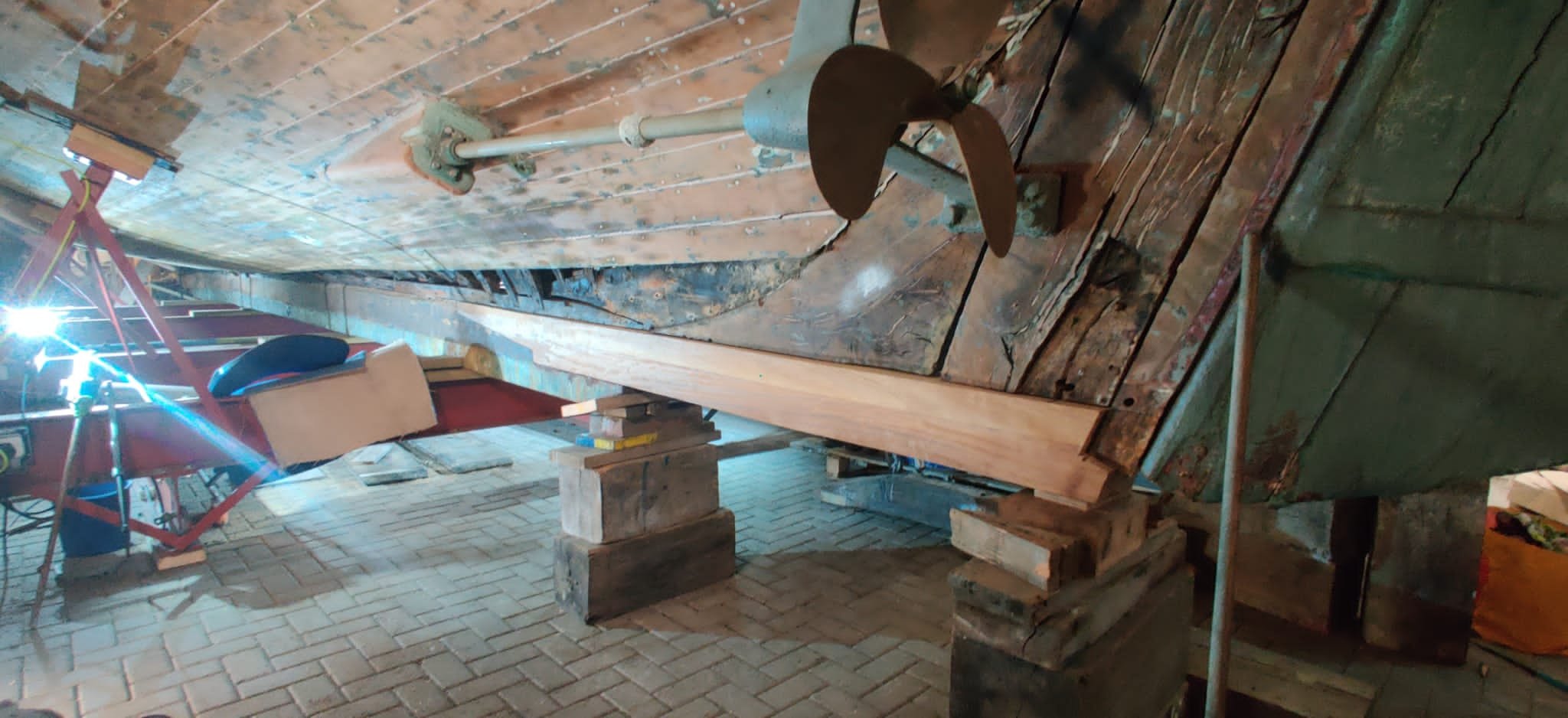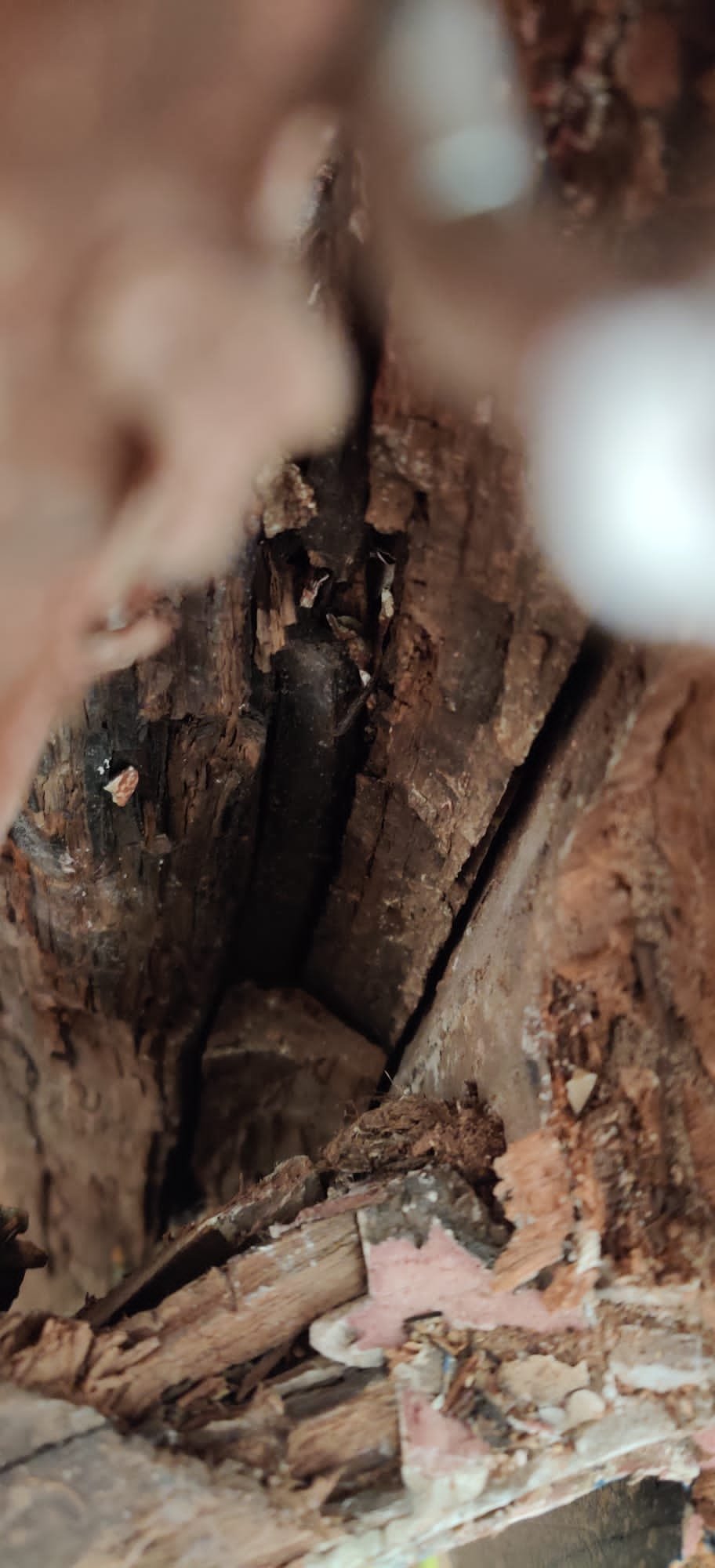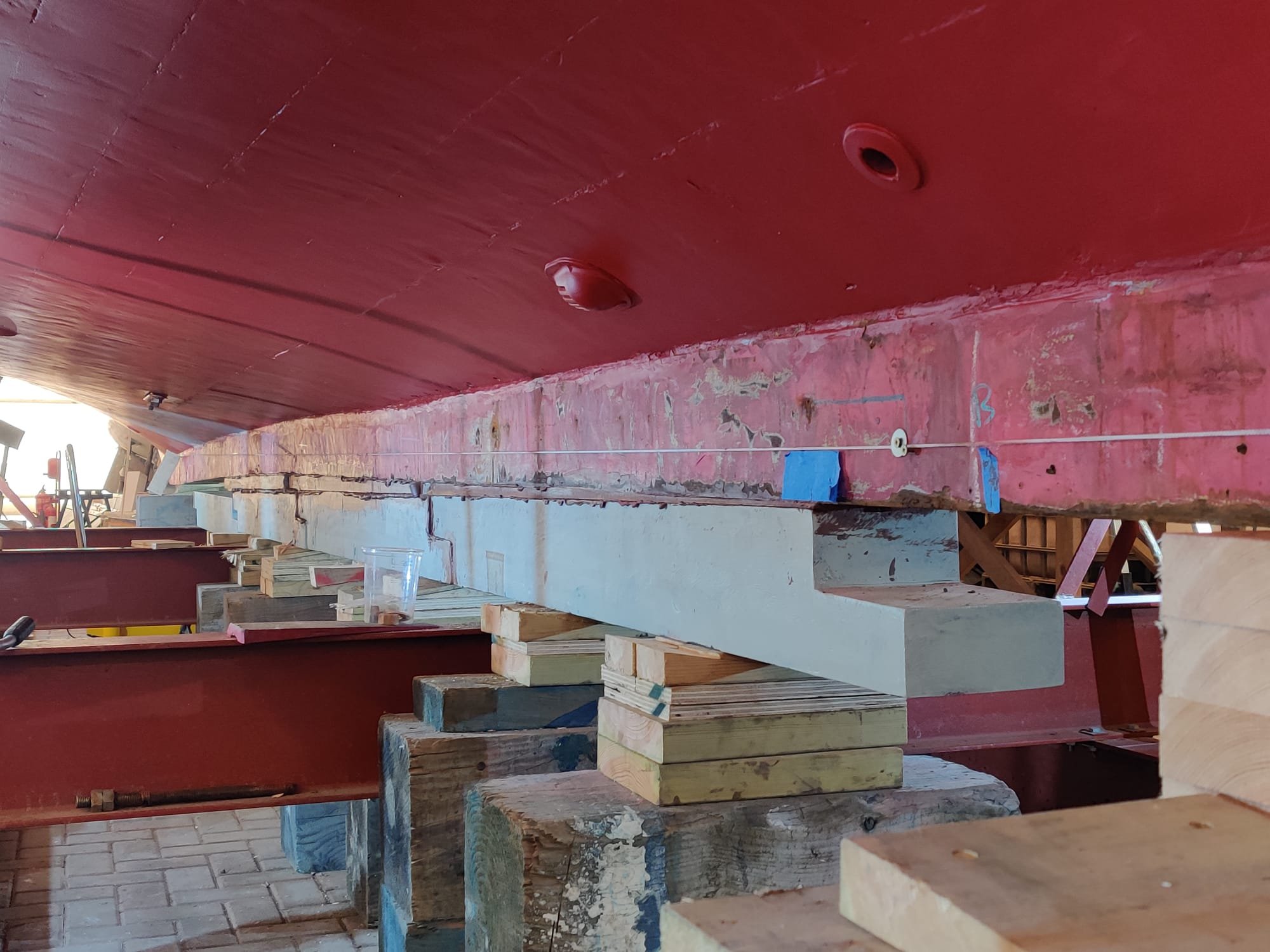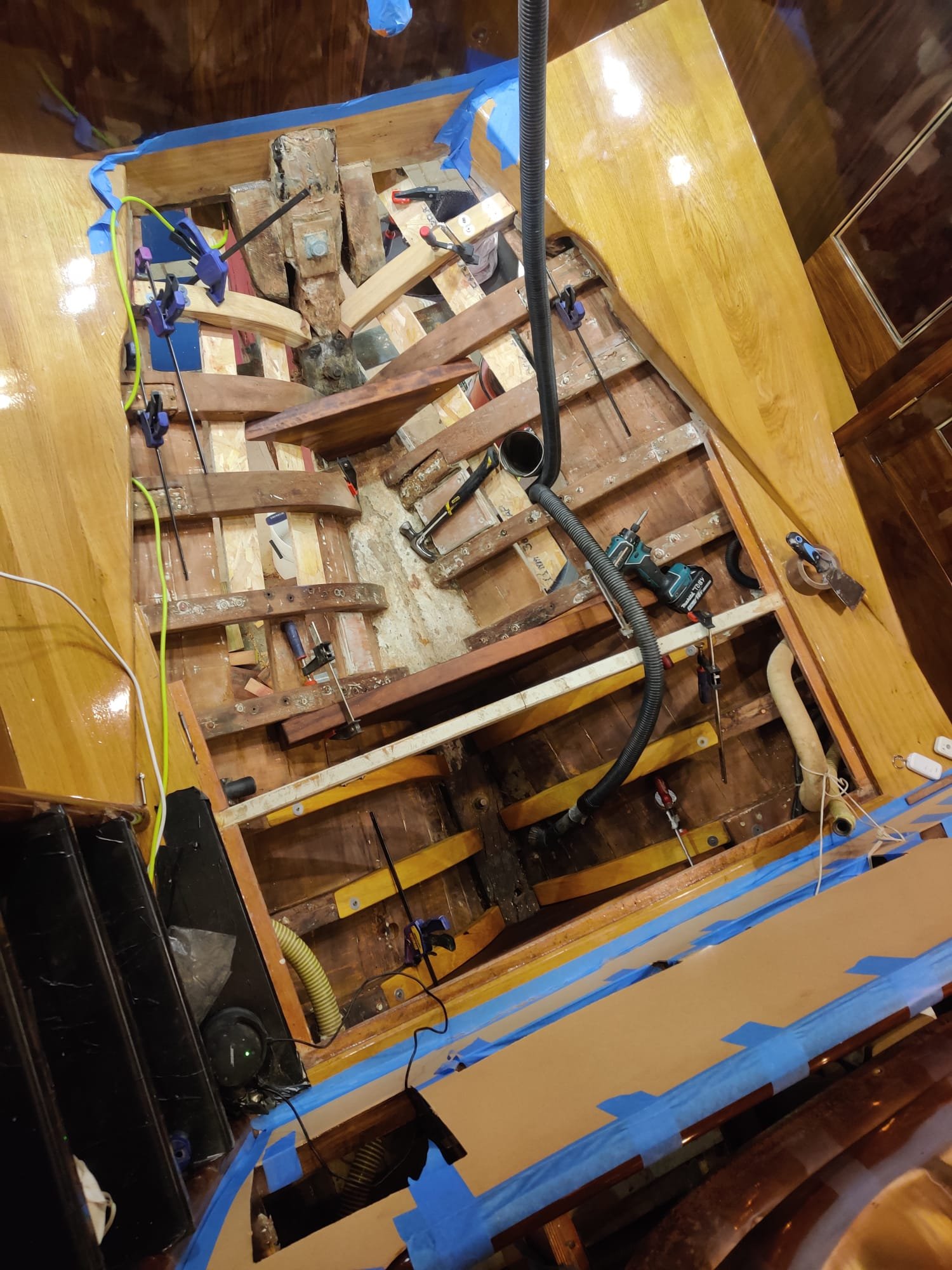
Refit 2020 - 2022: A Shipwright’s Tale
Key facts about the last refit
Replacement of centreline frames and floors fwd of the engine room bulkhead. 80% were replaced in total.
Complete replacement of the inner and outer stem all the way down to the wood keel.
Replacement bronze keel bolts where original iron and subsequent stainless keel bolts needed replacing due to corrosion.
Replacement of entire foredeck complete with a new sub-deck structure adding significant strength to further support the original structure.
Replacement 12ft section of the aft wood keel (which was part of the post 1940 Dunkirk damage) which joins with the original green heart wood keel.
Revised engineering plumbing systems for the Black holding tanks, Engine and Generator cooling and Air conditioning cooling.
Revising key electrical / wiring systems in the bilge to modern standards.
Adding an oak doubler or short ‘Keelson’ timber to brace historic damage found in her centreline structure between the Battery Room and Engine Rooms.
Installation of 630ah Lithium Ion Po4 battery bank in a new location fwd of the engine room.
Discoveries with Historical importance during the last refit
Working inside the fore locker and removing the bolted sections of non-original apron and other additional supporting timbers, it was found that Tahilla had vertical splits in her original oak stem of some 3 feet long. These had been hidden by the subsequent bolted apron and support timbers. Once the original apron and supporting timbers had been removed, a new apron could be laminated and secured into place down to the wood keel using the inside of the stem as a pattern / template. Next – using new silicone bronze fixings, Tahilla’s plank ends could be secured to the new apron inside. These new fixings were fitted some 2” aft of the originals as many of the plank ends were badly split and peppered with redundant holes from past attempts to secure her planking – another clue to the previous damage caused by her use as a Naval vessel in World War Two. The new Apron and plank fixings allowed the entire external stem and 2” of original plank ends to be cut from Tahilla’s bow. Doing so revealed more clues to one aspect of Tahilla’s story that until this point, had not yet fully been understood.
It had been largely accepted that the main area of Tahilla’s hull to have significant structural repair was her Stern Knee, Aft Deadwood, aft section of Wood Keel and Rudder / steering. These obvious repair areas were made with Green Oak which was used in abundance. All this stem damage is understood to be the result of damage at Dunkirk in 1940. While the repair materials and some methods look to be a touch crude to some – it’s clear that green or ‘Live Oak’ was the only material available to Tahilla’s shipwrights post 1940, and since they have directly contributed to Tahilla’s survival and are a valued part of her structure today, we continually work towards preserving them in good order.
So the Bow’s story was also now unfolding. We now know that;
There is a large split along the grain in Tahilla’s stem.
Additional bolted timber was put on top of her original apron – assumed to be additional support.
Looking at the bow with all the teak under waterline planks bare, the planking is not symmetrical from one side of the bow to the other. This is not a regular thing and further indicates that there was an incident involving this area in the past, probably due to her wartime service, possibly by running aground at Dunkirk.
Every plank end had redundant fixing holes, splits and graving pieces put in place
New windlass
Keelson being made
Keelson in place
New aft wood keel replacing some of the wartime 1940 repair timber
Whilst replacing the fwd floors and frames that are predominantly below sole level, the keel bolts were to be inspected and replaced as necessary. A mixture of stainless and iron bolts we’re discovered. Iron most likely to be the original bolts and stainless being a later addition (and not ideal as they would pass through oak). The replacement bolts would be bronze. Tahilla has an iron ballast keel beneath her original green heart wood keel. This addition of iron weight is not documented in her history so we were left to wonder why this was done. The Iron ballast keel hides the heads of the original iron keel bolts. This makes changing the iron keel bolts quite difficult unless the iron ballast keel is removed. Fortunately, the iron ballast keel has uniform bolt holes set into it when it was cast. New bolts were added right through the iron and into the new structural frames and floors inside where possible.
New stem
Around Tahilla’s midship area (in the battery room) there was a strange doubling timber bolted in place on top of the frames, it looked like a 1mtr long mast step and once this was removed we finally understood why it was there. The timber doubler was directly on top of a significant split in the keel timber (the timber that 90% of the frames in the vessel connect to). This was quite a discovery and was fresh news to her current owner. Despite what caused this split – the additional support timber inside the vessel and the non-original iron ballast keel beneath the vessel (also like a splint) was starting to add up. Could it be that they are there purely to brace this split??? We set about making a longer splint as we had plenty of access at this stage. The replacement support made of oak was installed as if it was a short keelson of some 4” thick 12” wide and 12 feet long and spanned the 2 midship bulkheads. Our final thoughts on what happened…we know now that both ends of Tahilla have suffered significant trauma and repairs. The stern damaged at Dunkirk, which is well documented, the bow likely to also have been damaged at Dunkirk.
Back to the drawing board and stepping back from the obvious, it could be that we have missed something. Tahilla has over time gained a slight curve in her keel line. This effect has been a slow process and we are reasonably sure that this was caused by the positioning of additional ballast inside her bilges to lower her bow for better trim. Whilst ballasting a vessel like Tahilla with additional loose ballast is an acceptable and common practice, it needs to be thought about. The positioning of ballast for trim needs to be placed above the region of the buoyancy that is lifting Tahilla’s bow. So in simple terms, the upward buoyancy effect needs to be pushed down with weight in the same location in order to avoid building stress in the vessel hull. If this simple rule isn’t followed then elevated structural loads are generated and over longer periods, the vessel’s structure could well begin to distort – just like Tahilla has! Think of a weight being added to a ruler that hangs over the edge of a table. With the table end of the ruler being held down flat…. The weighted end bends the ruler like the hogging effect we see in Tahilla. The curve in her keel line will be addressed in the next refit 2022/23 by the repositioning, under the keel, of the lead ballast. That will once again give Tahilla an absolutely straight keel line.
Rot in the stem
Split in the stem
New Apron
Where new and old meet: Apron and new floors
In the future Tahilla’s Iron keels are considered for removal. This will allow the remaining original iron bolts to be replaced. A shorter ballast keel of lead could be added to Tahilla’s bow to midship section, but not to her midship to aft section. Since Tahilla now has lighter propulsion machinery weight from a previous refit, she benefits from a higher trim line aft – but not quite on her build line from Thornycroft (the original 1922 shipwright’s markings for which are still visible when the paint is stripped). Removing the circa 500kg iron ballast keel under the aft cabin will further allow the transom to rise to her build waterline which also helps the bow to dip closer to the same build waterline and all helps to remove stress in her hull. A timber wood keel addition could be fitted under the aft cabin (in the same location replacing the older iron keel, which itself is not original, but a later addition) which will further support her repaired stern knee and add buoyancy, helping her back to her original waterline.
Striving to understand Tahilla’s 100 year journey to 2022 through reading and analysing her very fabric, and how it has been worked on through peacetime and war, have allowed us to prescribe an ongoing maintenance and improvement programme that best preserves her important historical features, whilst also keeping her in safe operational condition as a sea-going vessel. We look forward to working with her owners who’s drive to preserve her for the future is passionate.
Tahilla is sailing into her second century of service in as good a condition as the day she was first launched in 1922.
Andy Willett, Shipwright
Willett Marine
New electrical installation
A Shipwrights Tale - Part 2
Winter work 2022/23 was mostly well defined as it included many of the tasks we couldn't complete during last season’s forward of centreline structural strengthening, and I pick up from last years story above.
Being out of the water for is not ideal for a wooden yacht, but thanks to Tahilla’s solid teak planking she managed to stay in good shape. The areas that did give us some food for thought were the non-original Green Oak stern post, the aft deadwood and the rudder blade.
New stern repairs above Port propeller
These parts had been replaced during and after WW2 by Admiralty Shipwrights as a result of Tahilla (then known as Skylark) suffered battle damage at Dunkirk, taking part in Operation Dynamo (May / June 1940). These oak parts revealed significant splits which had occurred over the years.
In relation to the non-original green oak, in Spring 2022, after launch, we decided that we would allow the seawater to do its magic and allow these oak components to swell up and hydrate again. Sure enough, once out of the water again at the end of the season last autumn, the splits had shrunk and the oak timber had moved back into position.
Cutting gallery openings for rudder bolts
We had one persistent weep from the stern post remaining from the last refit in 2015 and no matter what we tried, only removing an area of hull planking and having a good look underneath was going to reveal the cause.
Before long it was clear that Tahilla had some localised rot in the oak sternpost around the waterline. This area of rot had been developing for some time - we could tell this as there were various sealants and weep stopping materials in the area, all doing something together, but not enough, and the persistent weep kept on coming. We suspect that the cause was freshwater coming down Tahilla's rudder stock, which is open to the environment at deck level, and then sitting in that locality causing the rot. During a recent visit to the boat, Tahilla's previous owner concurred that this was probably the cause.
New Ballast sections from astern
Counter timbers being strengthened with bronze bolts
Finished rudder blade getting epoxy coated
With the rudder box removed from inside the transom, we could gain better access and discovered that the counter timbers and frame heels were not in the best off health either. We could also see that Admiralty repair team back in 1940 had left the bilge stringers a little short of the centerline structure. After some team discussions, it was decided to sister up the what had been slightly rotten counter timbers (now saved) which would deepen the frame pockets so that the hull frames would be reattached once more. The additional thickness of the sistered counter timbers also allowed the bilge stringers to be reunited with the centreline structure again.
And lastly, in order to transfer some of the load in Tahilla's counter across the stern post, the counter timbers were capped with a continuous timber capping that is laminated and swept into the aft cabin and secured to the floors above the aft deadwood. These additional timbers will act like the horn timber seen in sailing yachts of similar construction.
Horn timber style stringers being laminated together
New floors and frames in the aft cabin
The biggest job was to remove the non-original iron ballast from under the wood keel. This was necessary as the iron was preventing access to the keel bolts. This iron has served well over the years, but it was not in a condition to keep, and so it was recycled. With the iron bars gone, we could inspect the mixture of metal keel bolts. As we suspected, they had corroded heavily and needed changing.
The keel bolts removed were a mixture of Iron (original) and stainless steel - (non original). This was the opportunity to re-ballast Tahilla with lead ballast under her wood keel. An infill under the wood keel and on top of the lead was devised leaving Tahilla with an absolutely straight keel once more. You can actually feel the difference in her as her new bronze bolts clamp everything together tight. The additional weight under the wood keel is supported by the new centerline structure that was fitted in last year’s winter refit. At that time, 50% more structural floors were fitted to carry some of her ballast weight lower and reduce the amount of loose lead ingots in her bilge.
Old and new keel bolts
As Tahilla’s master shipwright, I can now happily report to her owners that her hull has been thoroughly refurbished to make her probably even stronger than when she was first built, all her decks renewed, her electrical and power systems brought into the 21st century as with her navigation systems and her interior thoroughly refurbished and redesigned.
As good as, actually better, than new.
A unique, one off custom yacht with an extraordinary history.
1922 - 2023 and now in the best shape of her life for another century ahead of her.
A Shipwright’s Tale 3 – Winter 2024/25
With Tahilla’s hull frames, structural floors, Teak deck and ballast keel carefully brought back up to fine order last Winter, I can hear you asking what did you do in the final Winter of her planned ‘total refurbishment’.
Well, now was the time to attend to the painted topside planking. We have always been firm in our belief that if Tahilla had not been constructed from the finest pallet of materials 103 years ago – she wouldn’t have retained 99% of her original teak hull planking today.
For a number of years Tahilla has had movement in her topsides which has been caused by several factors; such as incorrect ballasting, alterations to the internal layout and, of course, general usage wear and tear. With these issues now resolved last Winter, the tightening up of the planking could now happen.
This process is like tightening a skin over a frame and gives the hull immense stiffness and stops the hull planks working individually, so instead the hull planking works as one component. The Keel Stringers and Carlins give the longitudinal stiffness, the floors frames and bulkheads give lateral stiffness – these items cover 2-dimensional stiffening. The deck and hull bring 3-dimensional stiffening which resists ‘racking’ and ‘twisting’ of the vessel's structure. She is now as strong as she was when she was built, maybe more so.
Tahilla has splined topsides, a method where long narrow timber wedges are glued between the planking joints after the plank caulking material has been applied. The important thing when replacing the splines is using the same quality and species of timber that was used when she was constructed – in Tahilla’s case this was teak.
The Shipwrights faced many challenges during this period of work. The shape of Tahilla’s hull is not exactly as it was 103 years ago - see previous Shipwrights Tales - that has developed from incorrect internal ballasting. This shape change has manifested into a tighter bilge radius in the stern quarters. Much of this area needed careful attention and much of the work here was done by hand to exacting specifications.
Other areas that attentive and innovative solutions were reinforcing around the hull portlights in the top section of the hull planking as the hull planks had been altered earlier in Tahilla’s life. The solution here was to sister up existing hull frames on the inside and letting in a ring of Tufnol (and inert cotton and resin sheet material) around the portlight openings to evenly transfer the hull stress around the portlight openings.
Another challenge which is not uncommon with older vessels is the gap between the hull planking that makes it hard to tighten the caulking material without going right through the other side.
Finally, with all the new splines glued into place, the hull topsides could be faired and repainted again repainted by hand. Modern filler was used to take up the rebate that we had created to tend to the splines.
After this we adopted the same paint system as before – that was to be Epifanes two pack polyurethane paint tinted to her trademark deep blue colour.
Tahilla is now in top mechanical, electrical and navigational condition, better and stronger than when first built, with the latest modern systems, but all hidden from sight so you still feel you are motor-sailing in the 1920’s.
Simply stunning. Just ask the crowds that surround her to look, take photos and ask us about her history every time we berth. In any and every port.
Testament to Tahilla, her history and the owners unfailing love of her.
And my team’s skills at Willet Marine.
She’s fit for another century. A unique vessel, a unique history, a unique way to enjoy being unique.
Andy Willett
Master Shipwright
During her restoration, Tahilla was often lifted out of water




























